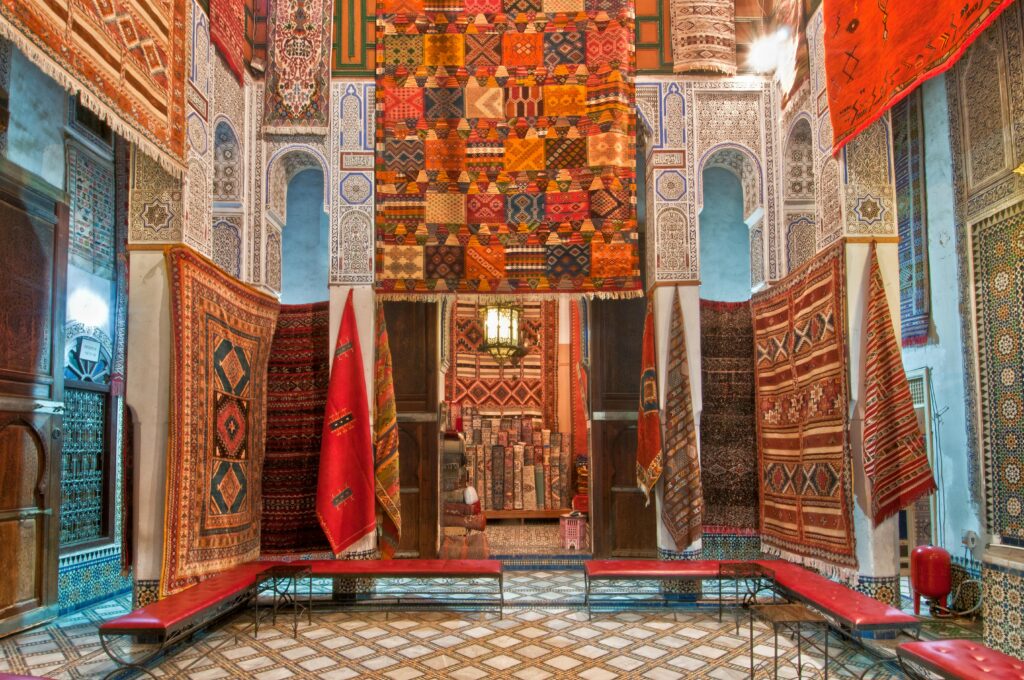
Moroccan rugs have captivated interior designers, collectors, and culture lovers for decades. With their bold patterns, symbolic motifs, and rich textures, these rugs bring warmth and heritage to any space. But with their rising popularity, it’s becoming harder to distinguish between genuine, authentic vintage Moroccan rugs and mass-produced replicas.
In this guide, we’ll walk you through how to identify an authentic vintage rug while also introducing you to the various types of Moroccan rugs that make each piece unique. Understanding these differences is key to making the right investment — one that adds both cultural value and timeless style to your home.
Why Vintage Moroccan Rugs Are So Special
Authentic vintage Moroccan rugs are more than just decor — they’re cultural artifacts. Traditionally handwoven by Berber tribes, these rugs were never made for commercial use. Instead, they were woven for personal use, ceremonies, or storytelling. Each piece is imbued with the identity of its maker, featuring imperfections that reflect the organic nature of the process.
Over time, these rugs gain character: their colors soften, the wool becomes even more supple, and their patterns tell silent stories of the past. That’s what gives vintage Moroccan rugs their unmatched soul and charm.
Types of Moroccan Rugs: Know What You’re Looking For
Before you can spot an authentic vintage piece, it helps to know the major types of Moroccan rugs. Each rug type comes from a different region and carries its own visual identity. Recognizing these types can help you spot inconsistencies or fakes.
1. Beni Ourain Rugs
- Origin: Middle Atlas Mountains
- Look: Creamy ivory background with dark geometric patterns
- Texture: Thick, plush wool
- Vibe: Minimalist and modern, despite ancient roots
These rugs are often counterfeited because of their popularity in minimalist interior design. A real vintage Beni Ourain rug will show signs of natural wear and may include symbolic details not found in factory versions.
2. Azilal Rugs
- Origin: High Atlas Mountains
- Look: White or cream base with colorful, often chaotic patterns
- Texture: Medium pile, sometimes mixed with cotton
- Vibe: Playful, bohemian, expressive
Because Azilal rugs reflect the personal creativity of the weaver, no two are alike. Machine-made versions often mimic the look but lack the irregularity and symbolic depth.
3. Boujad Rugs
- Origin: Haouz region (near Beni Mellal)
- Look: Bold pinks, reds, oranges with faded vintage tones
- Texture: Dense weave, shorter pile
- Vibe: Vintage glam, eclectic, romantic
Authentic Boujad rugs will typically show natural fading from age and use. New versions might look “too bright” or too symmetrical — a red flag for mass production.
4. Mrirt Rugs
- Origin: Middle Atlas Mountains
- Look: Sleek, geometric patterns in neutral or jewel tones
- Texture: Extremely soft and high-pile
- Vibe: Luxurious, modern
Vintage Mrirt rugs are less common because this style has only gained commercial popularity in recent decades. Still, real ones feel heavier and more tightly woven than cheap imitations.
5. Kilim Rugs (Hanbel)
- Origin: Various regions
- Look: Flat-woven, often striped or symbolic
- Texture: No pile, lightweight
- Vibe: Nomadic, rustic, versatile
Kilim rugs are harder to fake but still be careful — a handwoven kilim will have irregular edges and slight pattern shifts that distinguish it from printed textiles.
How to Identify an Authentic Vintage Moroccan Rug
Knowing the types of Moroccan rugs is only half the battle. Here’s what to look for when determining if a rug is truly vintage and handmade:
1. Check the Back of the Rug
Flip the rug over and examine the underside:
- Hand-knotted rugs show individual knots.
- The pattern should be visible, though less sharp.
- Machine-made rugs often have a mesh or fabric backing and perfect symmetry.
2. Feel the Texture
Vintage Moroccan rugs use 100% sheep wool, often undyed. The texture should feel:
- Soft but robust
- Slightly oily (natural lanolin from the wool)
- Not synthetic or overly smooth
Many fakes are made from polyester or synthetic blends and feel too uniform.
3. Inspect for Imperfections
Real handmade rugs are imperfect by nature. Look for:
- Slight asymmetry in shapes
- Uneven edges or fringe lengths
- Color variations or natural fading
These are signs of authenticity — perfection is often a red flag!
4. Look for Faded Colors
Vintage rugs, especially those using natural dyes, fade over time in a charming, uneven way. If the colors look too vibrant or “new,” it might be a replica.
Natural dyes age beautifully. Synthetic dyes don’t.
5. Ask About Provenance and Age
Ask the seller:
- Where was the rug sourced?
- Who made it, and when?
- Is there any documentation?
A reputable seller of vintage Moroccan rugs will happily provide this info and often knows the story behind each piece.
Tips for Buying an Authentic Vintage Moroccan Rug
Here are a few practical tips when shopping:
- Buy from trusted artisans or dealers who specialize in Moroccan rugs.
- Avoid mass-market online shops that offer “Moroccan-style rugs” — this usually means machine-made.
- Request photos of both sides of the rug if buying online.
- Measure carefully, as handmade rugs often don’t follow perfect rectangle shapes.
A truly vintage Moroccan rug might cost more, but it’s an investment in culture, craftsmanship, and character.
The Role of Types of Moroccan Rugs in Authenticity
Knowing the types of Moroccan rugs helps you evaluate authenticity more accurately. For instance:
- A “vintage Azilal rug” that lacks any bold color is suspicious.
- A “Boujad rug” that’s too perfect in symmetry is likely fake.
- A Beni Ourain rug with bleached white wool instead of ivory natural wool is probably machine-made.
The key is consistency between the rug’s story, look, and construction.
Final Thoughts: Buy with Knowledge, Decorate with Soul
Vintage Moroccan rugs are not just beautiful; they carry the spirit of generations. When you understand the types of Moroccan rugs and how to recognize authenticity, you can avoid cheap imitations and bring home a piece of Moroccan heritage.
Whether you’re drawn to the boldness of an Azilal, the minimalism of a Beni Ourain, or the timeless elegance of a Boujad, make sure your rug is the real deal — woven by hand, aged with time, and rich with story.
